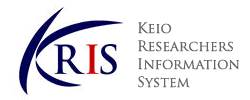-
Affiliation
-
Faculty of Science and Technology, Department of Physics ( Yagami )
-
Position
-
Associate Professor
-
Related Websites
-
Telephone No.
-
+81-45-566-1531
-
Fax No.
-
+81-45-566-1672
-
External Links

KEIO RESEARCHERS INFORMATION SYSTEM |
Details of a Researcher
このページはJavascriptを使用しています。すべての機能を使用するためにはJavascript を有効にする必要があります。
Furukawa, Shunsuke
|
|
|
RIKEN, Condensed Matter Theory Laboratory, Special Postdoctoral Researcher
University of Toronto, Department of Physics, Postdoctoral Fellow
University of Tokyo, Department of Physics, Postdoctoral Researcher
University of Tokyo, Department of Physics, Assistant Professor
Keio University, Department of Physics, Assistant Professor
Tokyo Institute of Technology, School of Science, Department of Physics
University, Skipped grade(s)
Tokyo Institute of Technology, Graduate School of Science, Department of Physics
Graduate School, Completed, Master's course
Tokyo Institute of Technology, Graduate School of Science, Department of Physics
Graduate School, Completed, Doctoral course
博士(理学), Tokyo Institute of Technology, Coursework, 2007.03
Characterization of Exotic Orders in Quantum Spin Systems
Natural Science / Mathematical physics and fundamental theory of condensed matter physics
Natural Science / Semiconductors, optical properties of condensed matter and atomic physics
topological states of matter
ultracold atomic systems
magnetism
Competition of topological and ordered phases in spin ladder systems,
Vortex lattices in Bose-Einstein condensates in synthetic gauge fields,
Quantum critical phenomena in non-Hermitian quantum many-body systems,
Theory of frustrated magnetism of volborthite based on a coupled-trimer model,
Quantum Hall physics of ultracold atomic systems in synthetic gauge fields,
High-Field Magnetism of the Spin-1/2 Two-Leg-Ladder Antiferromagnet Cu(DEP)Cl2 under High Pressure
Morimoto T., Morikawa E., Nihongi K., Kida T., Narumi Y., Honda Z., Furukawa S., Uwatoko Y., Kindo K., Hagiwara M.
Journal of the Physical Society of Japan 94 ( 2 ) 2025.02
ISSN 00319015
Phase Diagram of a Spin-1/2 Heisenberg Ladder with a Chirality–Chirality Interaction
Fontaine M., Furukawa S.
Journal of the Physical Society of Japan 93 ( 12 ) 2024.12
ISSN 00319015
System-environment entanglement phase transitions
Ashida Y., Furukawa S., Oshikawa M.
Physical Review B 110 ( 9 ) 2024.09
ISSN 24699950
Fontaine M., Sugimoto K., Furukawa S.
Physical Review B (American Physical Society) 109 ( 13 ) 134413 2024.04
Research paper (scientific journal), Joint Work, Accepted, ISSN 24699950
Ground-state phase diagram of a spin-1/2 frustrated XXZ ladder
Ogino T., Kaneko R., Morita S., Furukawa S.
Physical Review B (American Physical Society) 106 ( 15 ) 155106 2022.10
Research paper (scientific journal), Joint Work, Accepted, ISSN 24699950
Theoretical study of many-body effects in Bose-Einstein condensates in synthetic gauge fields
Furukawa, Shunsuke
学事振興資金研究成果実績報告書 (慶應義塾大学) 2019
Entanglement entropy and conformal field theory
S. Furukawa, J. Shiraishi
BUTSURI 69 ( 8 ) 541 - 546 2014
Article, review, commentary, editorial, etc. (scientific journal), Joint Work
Symmetry-protected topological phases and entanglement swapping in spin-1/2 ladder systems
Shunsuke Furukawa
[Domestic presentation] 高次にもつれた量子相探索の展開 (基礎物理学研究所、京都大学、京都) ,
Oral presentation (general)
Topological entanglement swapping in spin-ladder systems
Mizuki Hamada, Shunsuke Furukawa
[International presentation] SQAI-NCTS Workshop on Quantum Technologies and Machine Learning (National Taiwan University, Taipei) ,
Poster presentation
スピン梯子系におけるトポロジカルエンタングルメントスワッピング
濱田瑞貴, 古川俊輔
[Domestic presentation] 第70回物性若手夏の学校 (白浜荘、滋賀) ,
Poster presentation
Topological entanglement swapping in spin-ladder systems
Mizuki Hamada, Shunsuke Furukawa
[International presentation] The 4th Young Researchers' Workshop of the Extreme Universe Collaboration (Kyukamura Irago, Aichi) ,
Oral presentation (general)
System-environment entanglement phase transitions for open boundary conditions
Yuheng Sui, Shunsuke Furukawa
[International presentation] The 4th Young Researchers' Workshop of the Extreme Universe Collaboration (Kyukamura Irago, Aichi) ,
Oral presentation (general)
Grants-in-Aid for Scientific Research, Grant-in-Aid for Transformative Research Areas (A), No Setting
Theoretical study of many-body effects in Bose-Einstein condensates in synthetic gauge fields
Keio Gijuku, Academic Development Funds, Shunsuke Furukawa, Research grant, Principal investigator
Symmetry-enriched topological phases: theoretical foundation and proposal for realization
MEXT,JSPS, Grant-in-Aid for Scientific Research, Grant-in-Aid for Scientific Research (C), Principal investigator
Phase frustration in Bose-Einstein condensates in optical lattices
Matsuo Foundation, Shunsuke Furukawa, Research grant, Principal investigator
Exploration of topological orders in strongly correlated ultracold atomic systems and development of their fundamental theory
The University of Tokyo, FURUKAWA SHUNSUKE, Grant-in-Aid for Young Scientists (B), No Setting
The 2nd High Magnetic Field Forum Frontier Incentive Award
Shunsuke Furukawa, 2020.12, The High Magnetic Field Forum of Japan, Theoretical studies on quantum magnets with competing ferromagnetic and antiferromagnetic interactions
Type of Award: Award from Japanese society, conference, symposium, etc.
The 7th Young Scientist Award of the Physical Society of Japan
Shunsuke Furukawa, 2013.03, Physical Society of Japan, Entanglement entropy in quantum many-body systems
Type of Award: Award from Japanese society, conference, symposium, etc.
INDEPENDENT STUDY ON FUNDAMENTAL SCIENCE AND TECHNOLOGY
2025
GRADUATE RESEARCH ON FUNDAMENTAL SCIENCE AND TECHNOLOGY 2
2025
GRADUATE RESEARCH ON FUNDAMENTAL SCIENCE AND TECHNOLOGY 1
2025
BACHELOR'S THESIS
2025
LITERATURE OF PHYSICS
2025